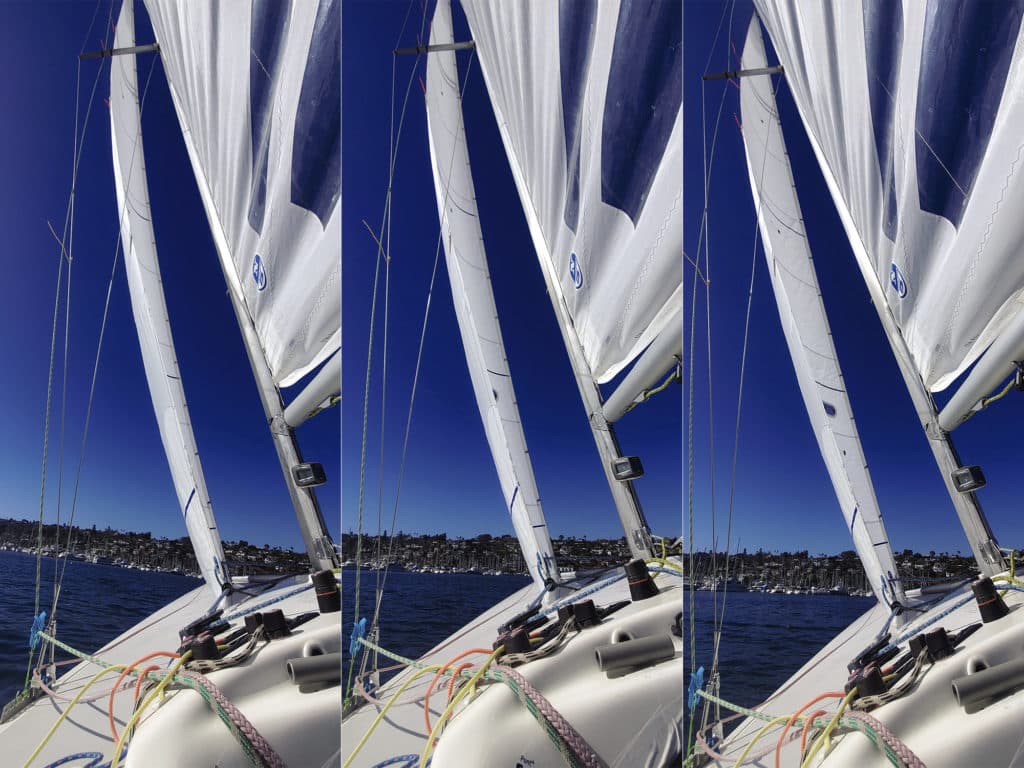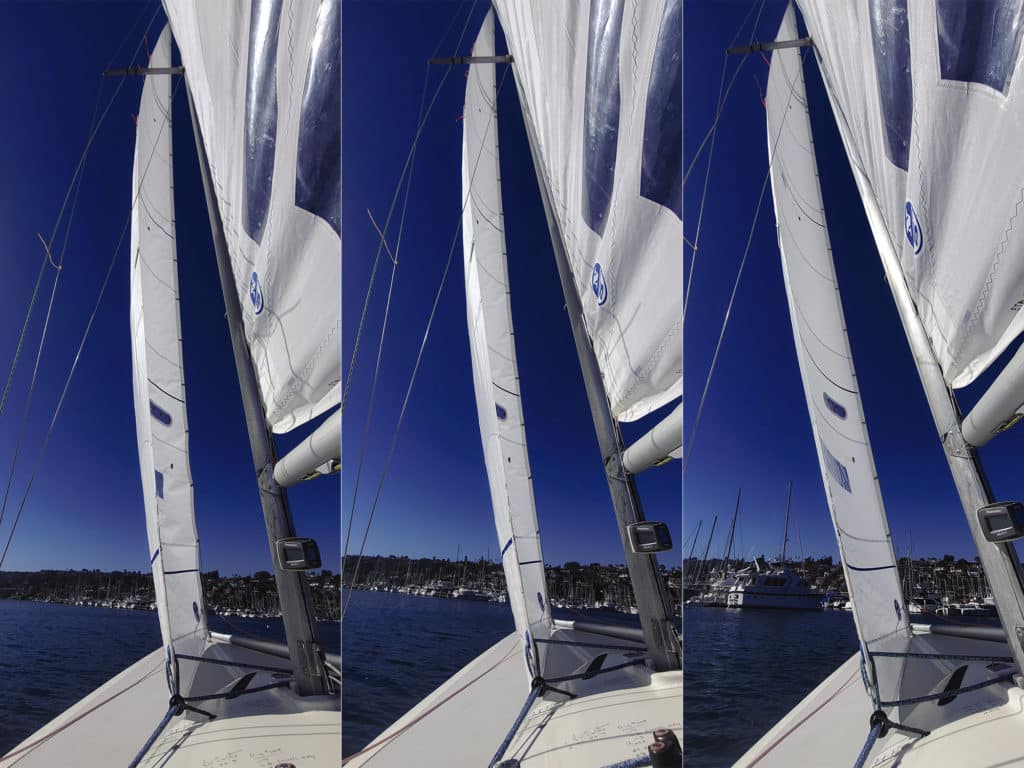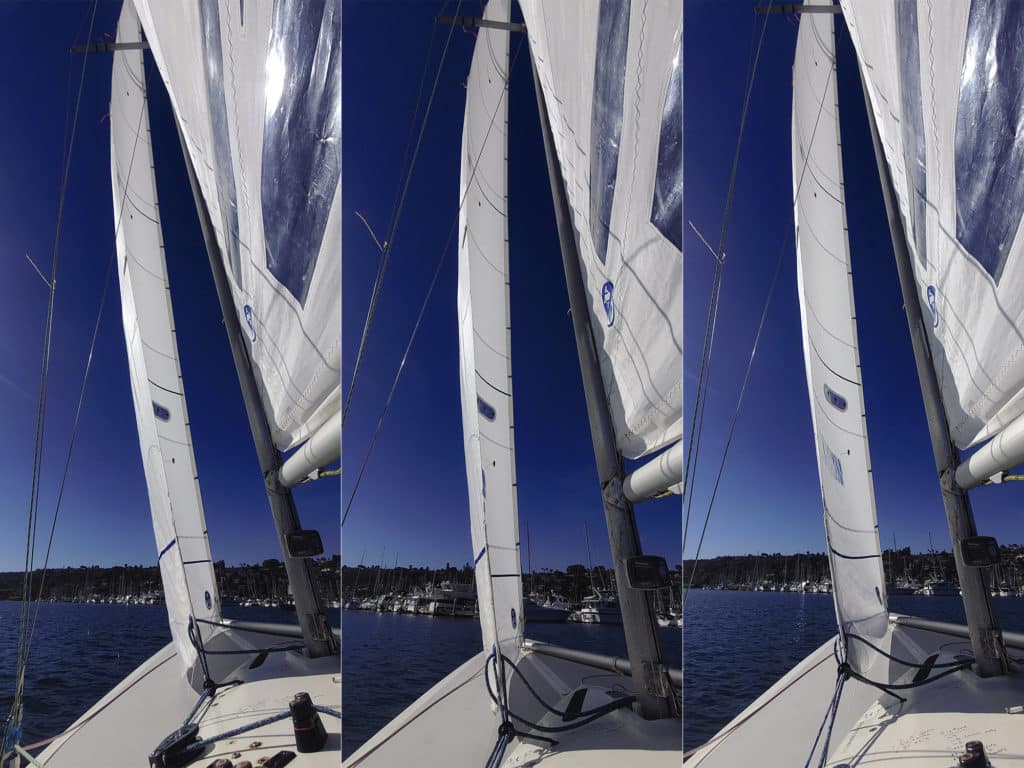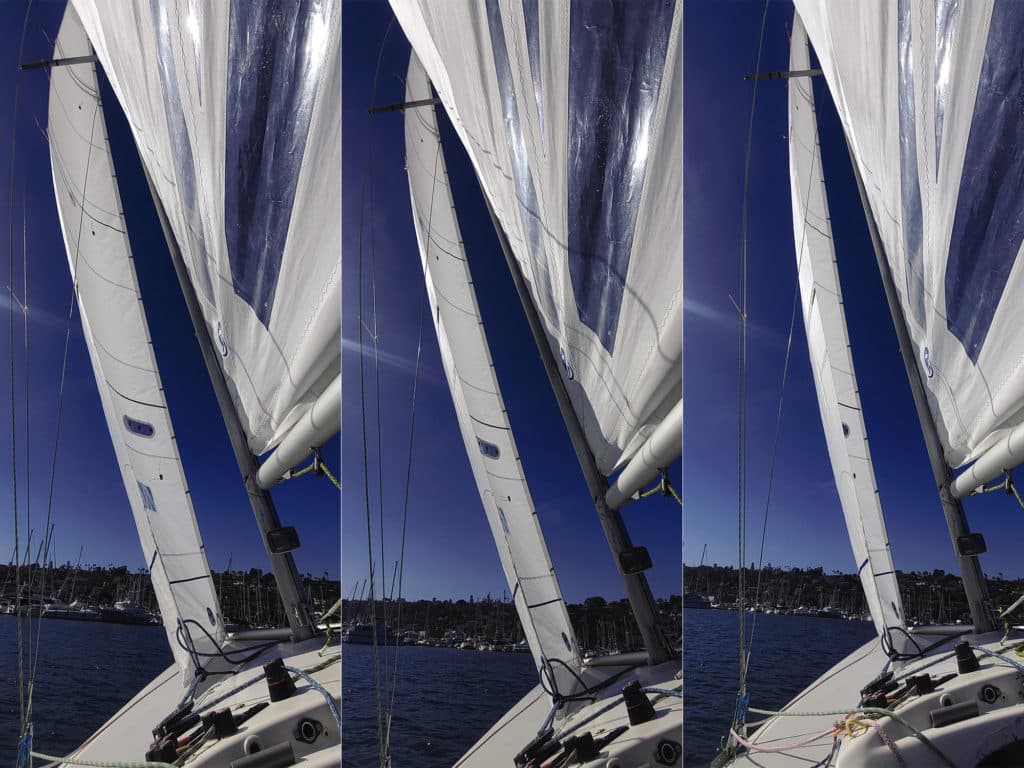Some people say the mainsail is the trickiest and most important source of power in the inventory, and be that as it may—depending on whom you ask—the headsail is incredibly dynamic and critical to everything that happens behind it with the mainsail. How the wind flows from over, around and behind dictates what happens when that flow reaches the main. Get the jib trim spot on, and the mainsail will do its thing. And with the jib, there are many influences—rig tension, halyard tension, sheet load and angle, to name a few. So, let’s break down the essentials to that flow working and getting the power where you want it.

Headstay Tension
Let’s start with headstay sag, which creates power in the headsail. In light air, a softer headstay powers up the sail by making it fuller. When it’s windy, a tighter headstay reduces power as it pulls draft out of the sail. And then there’s everything between those extremes. There are three primary ways to affect headstay sag—backstay, rig tension and mainsheet tension. The backstay is the most effective and often easiest to adjust of the three. An added bonus is the backstay also bends the mast, flattening the main. This helps keep the boat well-balanced. As puffs and lulls affect the sail plan, the backstay keeps both sails powered or depowered together.
The second option, for boats with aft-swept spreaders, is rig tension. By tightening the shrouds, you increase tension on the forestay. Generally speaking, given a fixed amount of backstay tension, tightening the shrouds creates more headstay tension. This is helpful if the mainsail is already flat and you don’t want to add more backstay, which might invert the main. Definitely check with your spar manufacturer or one-design guide about maximum shroud tension because it can add a lot of compression and load to the mast. Loosening the shrouds has the opposite effect, adding headstay sag.
The third option, mainly for smaller boats, is mainsheet tension. While its effect is different from boat to boat, mainsheet tension tightens or loosens the leech of the main, which in turn acts like a backstay—more mainsheet tension, more leech tension, less headstay sag.
As the headstay sags, draft gets deeper and moves forward because the sagging headstay puts shape in the front of the jib first. While a slightly deeper jib or genoa is often faster in light air, extreme forward draft is often not the solution when you need power. Enter halyard tension. As you sag the headstay, ease halyard tension, and the draft will shift aft. As you tension the headstay, pull the draft forward by tightening the halyard.
Until the boat is underpowered, headstay sag helps the boat point higher. That is in part due to the angle of attack. Imagine a straight line drawn halfway up the sail from luff to leech. As you sail upwind with a tight headstay, that line is, for example, 20 degrees off centerline to your boat. The wind flows over the boat and the sails are happy at this hypothetical position. As you sag the forestay, the front of the sail moves to leeward. That same imaginary line is now 15 degrees off centerline. Without factoring in other variables, your boat can now head up 5 degrees to keep the sail at the same angle to the wind.
While different boats seem to handle headstay sag differently, there are some common ways to determine if it is too much or too little. When it is windy and the boat is overpowered, too much sag can result in a lack of pointing. The jib is full because of the sag, and that pulls the bow to leeward. To make matters worse, if overpowered, the mainsail trimmer has likely depowered the mainsail. This compounds the problem of the sideways pull on the sail plan. A great coach of mine would often refer to this as “front loading” (or “back loading”) the sail plan. If you are front-loaded (powerful jib and depowered main), the boat will sail a little sideways upwind, resulting in lack of pointing. Lee helm is a sign of this.
Another key visual of excessive headstay sag is when the leech of the jib or genoa “returns,” or angles to windward, up into the mainsail. Trimming the leech close to parallel to the boat’s centerline is often fastest until it is very windy. If the leech returns into the back of the mainsail, it could be a sign that the headstay needs to be tightened. If the leech still returns into the back of the main after the headstay is visually tight, ease the sheet or move the lead aft. At the opposite end of the spectrum, if you’re too tight on the forestay, the boat will feel underpowered or lack pointing ability in light air, which takes us back to the earlier discussion about angle of attack.
When the boat is too flat and underpowered, and crew hiking isn’t needed, I carry as much headstay sag as I can without feeling that the jib leech is returning into the main, the headstay is becoming unstable due to chop or sea state, or the headsail’s draft is too far forward. In light air with a lot of headstay sag, often I ease the sheet slightly so that the leech doesn’t return into the main.
As the wind builds and the crew start hiking, I slowly reduce headstay sag. When everyone is fully hiking and the trimmers are looking to depower to reduce heel, I’ll be near maximum headstay tightness. From the trimmer’s position, the headstay will look nearly straight to the eye. What is maximum tightness? That’s when the backstay tightens to the point where the headstay is firm and the mainsail is too flat and starts to look like it is inside out. Sensors that measure headstay load can be helpful in knowing the load you are at and to confirm you aren’t loading above a manufacturer’s recommended safe working load.
Jib Halyard Tension

Halyard tension primarily controls the draft position of your headsail. A tighter halyard pulls the draft forward, while a looser halyard lets the draft aft. In general, most boats like the draft between 29 and 34 percent through the middle of the sail. Imagine a straight line from the leading edge of the draft stripe to the trailing edge of the draft stripe. A point on the draft stripe (think deepest part of the curve) is farthest from that imaginary line. This is your draft location. When we say draft at 30 percent, we’re saying that the deepest part of the draft stripe is 30 percent back from the luff to the leech on the sail. While we don’t see it often, marks on the draft stripe at 25, 30 and 35 percent can be helpful.
Two primary factors affect draft position, and thus how much halyard is needed to correct it. First and most important is headstay sag, discussed previously. As a headstay sags, it pushes depth into the front of the sail. Ease the halyard and you can get the draft back to the desired location. Inversely, if the headstay is tight and the shape in the front of the sail is pulled out, a tight halyard pulls the draft forward to the desired location. That’s why having good reference marks on halyards is so important. At a leeward mark, if the pit person puts the halyard back where it was at the weather mark, your draft location should be the same.
The second factor is the age of the sail. As a sail ages, the draft naturally goes aft. New sails have the draft quite forward, and thus require less halyard tension to achieve the desired draft location. The opposite is also true. As a sail ages and the draft slides aft, more and more halyard tension is required to pull the draft forward.
Once you understand how the halyard changes draft position, you can fine-tune the sail shape. What’s cool is as you pull halyard tension on and pull the draft forward in the sail, the aft part of the sail gets flatter. That causes less drag when overpowered. Likewise, when underpowered, less halyard tension makes the back part of the sail slightly fuller, which powers the boat up—great for light air and flat water. Now you can point high without fear of hitting a wave and slowing. It’s trickier in choppy conditions. Then, when powered up, a draft-forward sail helps drive the boat through the chop. In underpowered, choppy conditions, the sheet is likely eased a little to keep the boat going, and thus a softer halyard keeps the boat powered up, pulling it through the chop.
Jib Lead Position

Now let’s talk about lead position, which controls the overall camber of your headsail. While it does have an effect on the entire sail, it is most noticeable in the bottom 50 percent. Lead forward creates a fuller, more powerful headsail while lead aft flattens the headsail.
As a general rule, most boats prefer the camber between 11 and 15 percent through the middle and lower middle of the sail. Imagine a straight line from the leading edge of your draft stripe to the trailing edge of your draft stripe. A point on the draft stripe (think deepest part of the curve) is farthest from the imaginary line. This, like your draft location, is also your camber. We divide the length of the imaginary line connecting the front and back of the draft stripe by the length of the imaginary line connecting the deepest part of the sail to the closest spot on the imaginary line. When we say camber at 15 percent, we’re saying that the deepest part of the draft stripe is 15 percent of the overall length of the imaginary line connecting the front of the stripe to the back of the stripe.
While other factors affect the camber of a headsail, such as headstay sag, halyard tension, battens and the age of the sail, the lead has the greatest effect over the bottom of the sail. As you push the lead forward, the bottom of the sail becomes more powerful but also creates drag because the wind has to bend around the sail as it passes by. As you pull the lead aft, the bottom of the sail flattens, reducing drag but also decreasing power.
A large part of the headsail’s lead position is balancing the overall camber of the sail while keeping the telltales breaking close to even. Why do I say close? I believe it is a bit of a myth that they should break evenly. Aboard every fast boat I sail on, the top telltales break just a hair sooner than the lower ones. This is especially true when the boat is fully powered up with crew hiking. A slightly twisted open sail promotes full flow on the leech telltales while depowering the top of the sail first, which helps righting moment.
As I mentioned before, the age of the sail can result in an overly full sail. As a sail ages, it often requires a flatter foot to maintain a consistent camber. And, as with most things in life, balance is required. If a sagging forestay creates too much camber, lead aft can help. I find that balancing all of these controls is the key to fast sail shapes. Too much of one thing resulting in not enough of another can be slow.
Let’s look at when you want a full versus a flat-footed sail. Because it is a major control of overall power, is it safe to say that the more overpowered you are, the flatter you want your jib. When looking for power, a fuller jib is generally better to a point. If it is choppy and the driver must steer lower to keep the boat moving, a fuller jib will generally help keep the bow down and the boat powerful. In flat water, when powered up without fear that the boat will hit chop and slow down, the foot can be relatively flat and the jib sheeted hard to decrease drag and help pointing ability.
Jib Sheet Tension

While sheet tension might seem like the easiest part to understand when trimming a headsail, it can be the hardest to master. And while it has minimal effect on draft location, it can have a great effect on overall camber, balance of the boat and helm, and pointing ability.
Taking away other factors, when you ease a headsail sheet, the bottom of the sail gets fuller, while the top of the sail twists open and naturally gets flatter. As with lead position, a significant part of good headsail sheet tension is balancing the overall camber of the entire sail while keeping the telltales breaking close to even.
One factor when determining how hard to sheet the jib is backwind in the mainsail. In general, backwinding the mainsail is bad when it can be helped, and easing the sheet a little can really help settle down a luffing mainsail. As a headsail trimmer, I look for a bubble developing at the leading edge of the main, generally around a third up from the bottom of the sail. A slight bubble is often fine, but when the bubble starts “pumping” or the mainsail full-on luffs from front to back, I ease the sheet a little or let the jib lead aft to open up the leech.
Airflow across the sail is just as important, and the go-to indicator on nonoverlapping jibs is leech telltales. While we generally don’t see leech telltales on larger overlapping headsails, perhaps it would be a good thing to start doing. Leech telltale flow is critical for smaller boats because we generally try to sheet as hard as we can without stalling them. By sheeting the headsail tight, we allow the boat to point as high into the wind as it can. I watch the upper leech telltales like a hawk. While mainsails seem to be OK with a little stall in the top telltale, I find that headsails enjoy 100 percent flow. I will often test my sheet tension by sheeting harder until the telltales start to stall behind the leech, and then ease it slightly until they fly again. When we’re in a tactical situation that requires sailing a little higher and slower, I will occasionally sheet hard enough that the top leech telltale stalls 10 percent of the time, but never more. These changes are always subtle. On a boat like an Etchells, I’ll move the clew through a range of 3 to 5 millimeters. On a larger boat such as a 50-footer, 8 to 12 millimeters would be a decent range.
We’ve got headstay sag, halyard tension, lead position and sheet tension. None of these functions in isolation. Adjust one and it affects something else.
Finally, with so many variables and adjustments, the jib leech tension changes a lot through puffs and lulls. In a lull, often the leech will get tighter because there is less wind stretching it out. This often requires a little ease. Of course, the opposite is true in a puff, and then I’ll bring the sail in a little. It’s vital to communicate with the tactician and driver. Within your final headsail settings, you have the capability to help the boat sail in three different modes: slightly higher and slower, slightly lower and faster, and normal velocity made good (VMG). For tactical reasons, the tactician or helmsperson might want one of these modes.
OK, let’s put it all together now. We’ve got headstay sag, halyard tension, lead position and sheet tension. None of these functions in isolation. Adjust one and it affects something else. It’s a bit like juggling four balls—the only way you’ll keep them in the air is if you keep them in sync. Let’s sail a hypothetical windward leg, one where we encounter puffs and lulls, and have to account for the occasional tactical situation. Hopefully, by seeing how I manage those elements of jib control, you’ll have a better idea of how you can keep all the balls in the air and work toward perfect jib trim. For this windward leg, I’m sailing with the tactician, Steve, the helmsperson, Jim, and our wind caller, Serena.
First, we did our homework. We spent some time sailing upwind before the start, which gave me time to set up the jib as I liked for the conditions, around 8 knots and flat water. With that trim as my normal upwind VMG, we now have a baseline for everything else I’ll do with the jib.
At the start, I’m at 95 percent trim from my baseline. This means I’m close to maximum sheet tension. It’s good for accelerating at a start or out of a tack, or reaccelerating after hitting chop.
At the start, I’m at 95 percent trim from my baseline. This means I’m close to maximum sheet tension. It’s good for accelerating at a start or out of a tack, or reaccelerating after hitting chop. The boat’s moving well and we’re accelerating, as are the boats around us. After a boatlength or two, I feel the boat moving at full speed, so I pull in the sheet just a few more clicks and say, “Max trim” or “100 percent trim.” That tells Steve and Jim that we are trimmed for our best upwind VMG. How do I know this? The leech telltales are flowing 100 percent, but just barely. They are on the verge of stalling because they seem jittery rather than fully streaming. As it is only blowing 8 knots, I have set up the jib powerfully, with 3 to 4 inches of headstay sag, the lead set forward to allow a fair amount of power down low, and slight wrinkles in the luff, allowing the draft to slide back to around 30 percent.
Steve starts talking about seeing more wind on the top left side of the course and says we should go fast forward to the left. As the headsail trimmer, I can help make that happen. It’s all simple, subtle changes. I ease the sheet a few millimeters to let the top leech telltales stream with force. If it was windier, I would pull the draft forward with more halyard. This would flatten the back and reduce drag, helping the boat go forward. However, because it is light and we are still looking for maximum power, I will leave the halyard soft. Combined with efforts from the main trimmer and driver, we shift to a low and fast mode.
As we get out to the left side, the wind starts building, as predicted, to 12 to 13 knots. We are fully powered up and hiking hard, but we’re heeling too much. It’s time to depower the headsail. Because the water is so flat, I ask for more backstay to pull out some forestay sag, and then slide the lead aft a hair. As the backstay tensions, I see the leech open slightly, so I pull on some sheet to get the leech right back where it was, with the top leech telltale flowing as before. I have also pulled on more halyard to get the draft forward to the 29 percent range.
We’re now solidly in the pressure, and Steve says we should go back to normal VMG. On comes the jib sheet to get the top leech telltales just on the verge of stalling. “Max trim,” I say. A minute or two shy of the layline, we tack onto port and work our way back into the middle of the course.
As we come out of the tack, I say “90 percent trim.” Just a few seconds later I say, “95 percent.” Seconds later I say, “99 percent.” I really want to make sure we are at full speed before getting to 100 percent, or max trim. As we get back to the center of the course, the wind becomes a little puffy. I’m constantly watching the leech to see if I need to sheet on or off as the leech changes slightly with the puffs. I’m moving the sheet through a range of just 5 to 10 millimeters. Serena calls that this next lull will last at least a minute or longer, so I power the jib up a little with a softer halyard.
As we get closer to the mark, a competitor tacks in front of us and slightly to leeward. Steve says he would prefer not to tack. To keep our air clear for as long as possible, it’s time for a high mode. We’re still in that lull and not overpowered, so I call for a slight backstay ease. That sags the headstay a little, helping the sail’s angle of attack to the wind—all great for pointing. As the headstay sags a little, the leech telltales want to stall sooner, so I am vigilant about not overtrimming the sail. I know—it’s counterintuitive to have the sheet out a little when trying to sail in a high mode, but it’s important not to stall the jib. If the boat slows too much, the keel does less work, and we will start sliding to leeward. After the changes, we are higher and slower, and able to hold our lane.
The wind builds again, and Serena calls out that there is a chop ahead of us, mostly caused by competitors’ wakes, which are crisscrossing everywhere. A little draft forward in the jib will help us punch through the chop in the stronger wind, so I tighten the halyard a little, and the draft moves from 32 to 30 percent. As an unwanted side effect, the leech gets tighter because the halyard is pulling against the sheet. I can tell this because the leech telltales start stalling. I must either ease the sheet a little or let the lead move aft. If we’re looking for power to get through the waves but not to be overpowered, I generally just ease the sheet, which not only opens the leech but also powers up the bottom of the sail. However, right now we are fully powered up, so a little lead aft opens the top of the leech back up, depowering the sail a little. We’re now just boatlengths from the weather mark.
We don’t always run into that many different conditions, but for our purposes, I threw them in so you could see the range of my trimming routine. I try to remember that headsail shape always needs to change based on changing conditions and tactical decisions. I imagine a perfect shape—how I want the jib to look in each condition—and then use the four controls to achieve that. And I’m always anticipating, constantly asking myself what my next change will be if this happened or that happens. I listen to our crew calling puffs and stay ready with a change before the boat slows or heels too much.
One change often affects another part of this hypothetical shape and, as I emphasized earlier, multiple changes often go together. If you can manage that while staying on the same page as the rest of the crew about what mode you need to be in, you’ll go a long way toward keeping the jib optimally trimmed the entire weather leg.









